BACK TO HOME
Tapping & Tubing
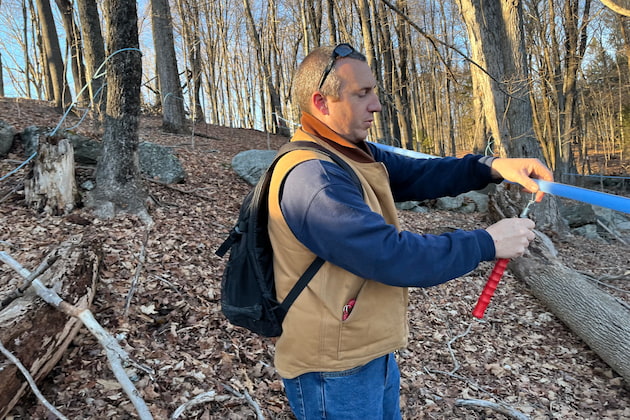
Producers encouraged to find their 20-day 'money window'
Peter Gregg | January 16, 2024
THOMASTON, Conn.—When to tap?
That’s always the sugarmaker dilemma every season but this year it seems more pronounced than others.
Wild weather and big temperature swings across the Maple Belt has had producers excited one minute and hesitant the next.
Contributing to the matter are Facebook posts from big producers who are forced to tap early because of the size of their operations, and capture early sap runs in December and January.
When to tap was the big topic of conversation this weekend at the annual meeting of the Maple Syrup Producers Association of Connecticut.
“I’m not sure when I’m going to start this season,” said Mat Wilkinson of 800-tap Wilkinson Maple Farm in Columbia, Conn.
Offering some perspective was the keynote speaker at the meeting Bradley Gillilan of Gillilan Family Maple in Fletcher, Vt. who is a tubing installer and consultant to sugarmakers across the nation.
[ MORE ]
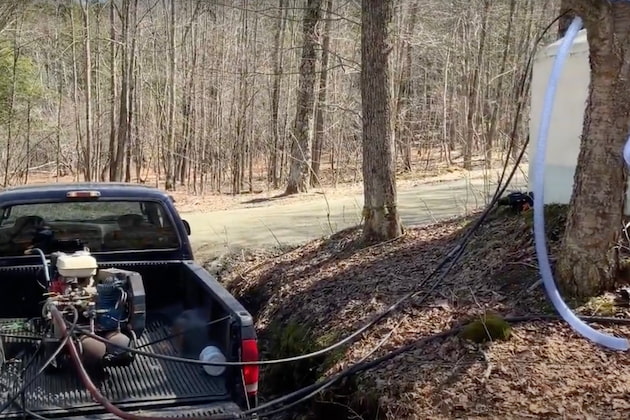
Vermont sugarmaker offers tips on tubing cleaning
Peter Gregg | November 3, 2023
SOUTH WOODSTOCK, Vt.—One of the biggest debates in maple is over the best method for cleaning tubing, or even bothering to clean it at all.
At 1,200-tap Top Acres Farm in South Woodstock, Vt. sugarmaker Mary McCuaig has developed what she says is a tried and true method.
"We use a weaker chlorine solution and begin cleaning as soon as the season ends," she told The Maple News.
"This method has allowed us to avoid replacing spouts and droplines annually and still keep yields high," McCuaig said.
"We average over half gallon of syrup per tap, and our sap is clean, starting with the first sap run."
McCuaig has posted three YouTube videos explaining her method under her YouTube channel- marymccuaig3249. [ MORE ]
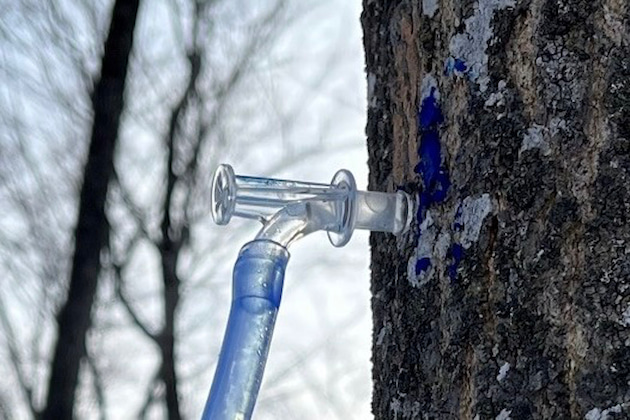
Proctor reports on 2023 season barb-spout results
By Timothy D. Perkins & Wade T. Bosley | May 18, 2023
UNDERHILL, Vt.—The outermost rings of wood in maple trees have the highest sap flow rates and have sweeter sap than the wood found deeper in the tree.
In addition, during the early part of each season there are several periods when thawing is too brief and shallow to allow sap to be collected.
This is because typical maple spouts have elongated barrels that are inserted well into the wood to anchor them in place. While this design feature of spouts reduces the tendency of sap to dislodge during deep freeze periods, it doesn’t permit sap collection during brief thaws.
Taken together, these factors reduce the amount of sap that can flow from tapholes.
Over the past five years researchers at the UVM Proctor Maple Research Center have explored different approaches to reducing these limitations in order to maximize sap yields.
One obvious solution would be to shorten the spout barrel to permit sap to flow more readily from shallower wood tissue. A consequence of this is reduced spout stability and an increased probability of spout heaving during deep freeze periods. [ MORE ]
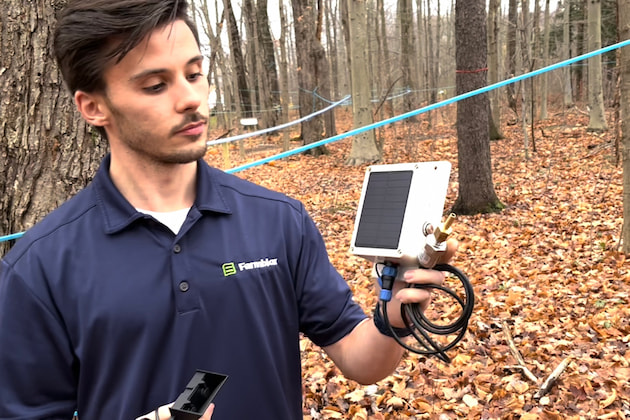
Farmblox to host open house this weekend in St. Albans
Peter Gregg | April 26, 2023
ST. ALBANS, Vt.—The Farmblox folks are inviting sugarmakers to visit Holyoke Farm, a Farmblox producer, for a special event this weekend in St. Albans, Vt.
There, sugarmakers can see a monitoring system in action in the sugarbush.
"Get all of your questions answered about the most flexible sugarbush monitoring system on the market and see how you, too, can benefit!" said Farmblox president Marc Printz.
Here's the Open House event page to link to: https://farmblox.ag/open-house
[ MORE ]
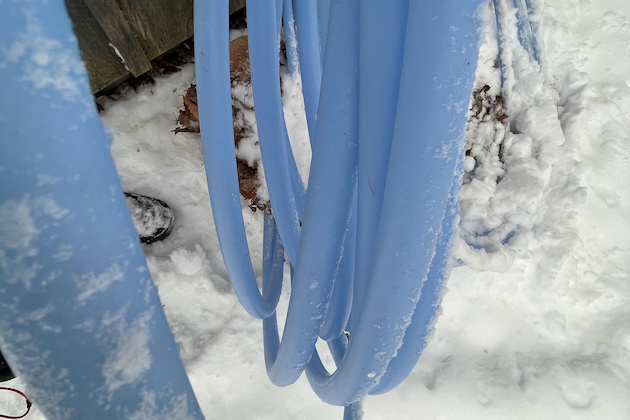
Raging debate on 3/4 pipe
Peter Gregg | April 10, 2023
PLYMOUTH, N.H.—Love it or rip it out?
A debate is starting to swirl between expert installers on the effectiveness of three quarter inch mainline. Some experts are advising that the narrow mainline does not do well transferring sap on vacuum.
“Regardless of the situation, airtight or not, there are always downsides to using 3/4 in. tubing,” said expert Joel Boutin, an advisor for the Quebec Maple Cooperative. Boutin was a guest speaker at the Vermont Maple School in December who emphasized his dislike of 3/4 inch pipe.
Boutin said that 3/4 inch mainline often acts like 5/16ths lateral lines, overfilling with sap and taking up too much space for air. He said big bubbles will form in the tube and decrease vacuum the further away from the pump.
“3/4 tubing can only carry sap from very few taps with the new yields people can get now,” Boutin told The Maple News. “In fact, it is less than 100 taps if you do more than 6 lbs per tap." [ MORE ]
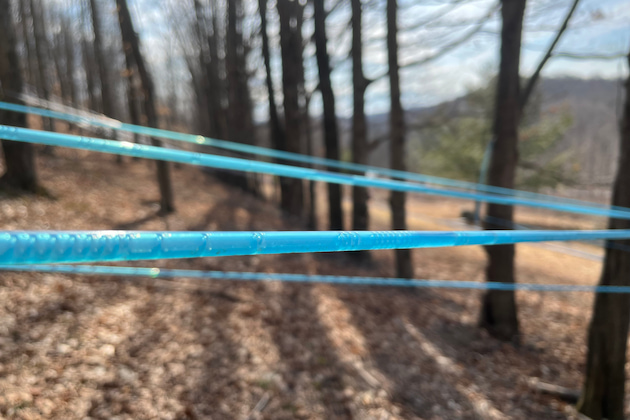
Many sugarmakers sticking with 3/16 tubing
Peter Gregg | March 29, 2023
BOW, N.H.—The reputation of 3/16ths tubing has taken a beating the past couple of years, with sugarmakers gloriously ripping it out of their woods and declaring it a short lived fad.
But there are plenty of sugarmakers that have stuck with the natural vacuum technology, and say that it works for them, and is effective in getting high vacuum from gravity instead of a pump.
The key? Lots and lots of slope.
“Yes it seems the better the slope the better it works and less likely it is to plug up,” said Brandon Daniels of Daniels Pure Maple Syrup in Grassy Meadows, W.V.
Daniels is something of a 3/16ths guru in the Mountain State, where the narrow tubing still rules.
“We are blessed to be able to tap trees on eight properties and we have 2,500 taps on CDL 3/16 natural flow vacuum,” he said.
West Virginia has some of the steepest slope in the Maple Belt, which is why, anecdotally, the technology seems to work there.
[ MORE ]
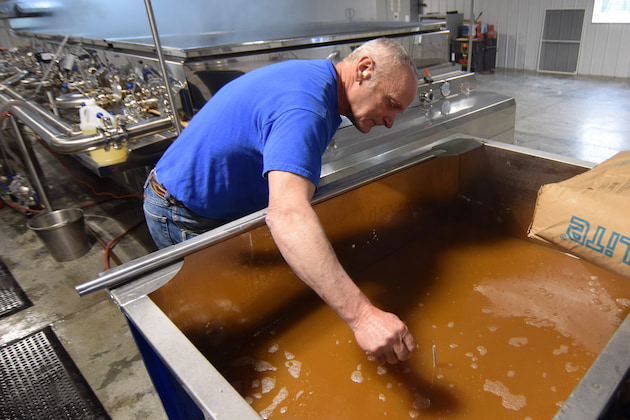
Tips from Glenn: Goodrich shares his secrets
Peter Gregg | February 14, 2023
PLYMOUTH, N.H.—Sugarmaking legend Glenn Goodrich was the featured speaker at the NHMPA annual meeting on Jan. 21, offering advice on tapping, vacuum and boiling.
“Getting a true round hole in the trees is essential,” Goodrich told producers on his tapping methods. Goodrich has a 160,000-tap operation in Eden, Vt. and Cabot, Vt. and is recognized as one of the U.S.’s premier sugarmakers, winning countless awards.
Goodrich says as he and his crew of tappers march from tree to tree, he estimates he taps a tree in 35 seconds before moving to the next one.
“I fire the drill to the highest speed the drill can spin,” he said, before sinking it into the tree at a maximum depth of no more than 2 inches, or sometimes just one inch on marginal trees.
After the hole is drilled, he uses a nylon-headed tapping mallet to knock in a spout, but with not too much force.
“It’s all in the wrist,” he said. “We’re not knocking in the spout with a 24-ounce Estwing hammer as hard as we can. Don’t do that.”
He said most taps usually get “six hits,” with the mallet.
Once he’s tapped, the vacuum generally runs continuously at the farm.
“I will shut off the pumps only if I know the trees will be frozen for at least 10 hours,” he said. [ MORE ]
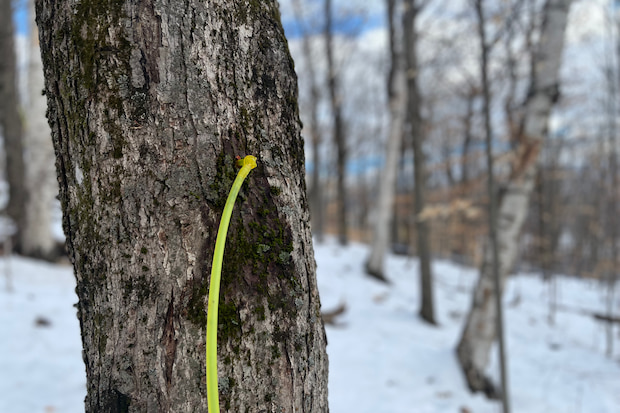
What to do about weepy tapholes?
Peter Gregg | February 10, 2023
FAIRFIELD, Vt.—What to do about weepy tapholes?
As sugarmakers across the U.S. race into the woods this week during an unusual warm-up, some are scratching their heads over a common phenomena—sap leaking out of the taphole and spreading around the trunk.
Expert tappers generally agree that the leaks are caused by poorly drilled holes.
“Wobbly or oval holes, I would say is the cause,” said Evan Branon of 80,000-tap Branon Family Maple Orchards in Fairfield, Vt. Branon is the inventor of the Precision Tapper, a drill attachment sold by CDL that helps the sugarmaker drill consistent and straight holes in the tree.
Still, for those who don’t own that equipment, sugarmakers can ensure proper holes by using good technique.
“We always want to use two hands to steady the drill,” said 160,000-tap sugarmaker Glenn Goodrich of Goodrich Maple Farms in Cabot, Vt. who led a seminar on tapping at the New Hampshire maple school last month.
Goodrich said that if a sugarmaker finds a weepy hole after drilling, he/she should not go back and pound the tap in harder with the mallet.
“Just leave it alone and check back on it in a few days,” he said, suggesting that the hole oftentimes will seal up on its own.
[ MORE ]






























